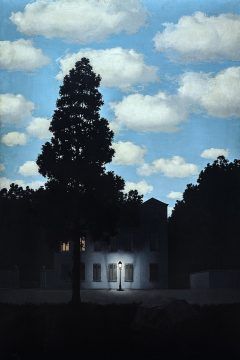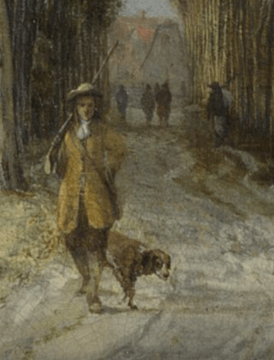by Joshua Wilbur

There are times when I can’t look away from The Avenue at Middelharnis.
Completed in 1689 by the Dutch Golden Age artist Meindert Hobbema, the painting has entranced viewers for centuries. The English landscapists of the Romantic period admired and emulated its unusual composition. A young Van Gogh saw The Avenue in London’s National Gallery in 1884. “Look out for the Hobbema,” he would later write in a letter to his brother Theo. René Magritte allegedly produced forgeries of Hobbema’s paintings, and his Empire of Light seems to me a surreal reinterpretation of the Dutch master’s masterwork.

I say that I can’t look away from the painting because I set it as my computer’s background a few months ago. Artsy, I know. I see The Avenue a few times a day, usually in browser-obscured flashes. Sometimes I’ll push everything aside and just space out into it.
The painting is a great example of an “open” work of art. As described by Umberto Eco, open works encourage multiple interpretations and respond to the viewer’s evershifting historical situation, stage in life, or mood. If closed creations communicate one thing, open works communicate many things. They meet us where we are. I should say something about where I am and where we are before going further down The Avenue.
Never have I felt so overwhelmed by news and media. With apologies to Virginia Woolf, on or about March 2020 human character changed. In that watershed month, which will forever divide the Pre- and Post-Covid eras, a decades-long obsession with “WHAT’S HAPPENING RIGHT NOW?” ballooned into an apocalyptic psychosis. The End of the World™ is now available 24/7 on your television, smartphone, and tablet. We’re all “doomscrolling,” addicted to our daily dose of dread. It’s as if American culture has fallen into a self-perpetuating state of despair. A depression, in other words.
Of course, our institutions are broken, and the national conversations flooding into our phones, homes, and heads are vital. It’s obvious that the social sphere needs a complete reformatting. The problem is that Americans are collectively unmoored from any fundamental principle, higher purpose, or spiritual direction—(ignore the religious terminology if it bothers you). Just ask yourself the question: What is America really for? Now imagine this same question being posed to every U.S. citizen (all 330 million of us), and you’ll understand why today’s “pursuit of progress” is so stressfully incoherent.
It’s against this backdrop of facts and feelings that I’ve been zoning out to a landscape painting from the 17th century. The Avenue at Middelharnis implicitly addresses an idea that’s occupied me throughout this heavily mediated year, namely that people depend on and revert to extraordinarily narrow forms of thinking, speaking, and looking. Psychonauts like Timothy Leary and Robert Anton Wilson used to talk about “reality tunnels” when describing the neurological process by which human consciousness carves out a comprehensible space amid trillions of sensorial, cultural, and genetic inputs. To be conscious is to “tunnel” through a small sliver of reality. Leary and Wilson expanded the tunnel metaphor to cover entire cultural domains, so that any time a person participates in a shared system of experience—Christianity or Buddhism, 50’s rock n’ roll or 90’s hip-hop, Fox News or CNN—wooooosh, they’re cruising down a distinct reality tunnel (or Avenue).
Now consider the visual effect of Hobbema’s painting. Here’s the British artist David Hockney discussing The Avenue at Middelharnis in an interview: “What’s fascinating is that […] there are two vanishing points. One is in the center of the painting, with the disappearing road. But the other is in the sky. You’re always looking up, because the trees are so tall.” Ostensibly, the action of the painting is down below, at the level of the road, the field, the church—the title indicates as much. But the real drama is up in the trees and sky, at an indeterminate central-high point to which the eye is inevitably drawn. To me, the intention is clear: Hobbema is compelling the viewer upward, away from human concerns and into the realm of natural mystery.

In place of a reality tunnel, the metaphor I’ve had in mind lately when watching the news and looking at The Avenue is that of a magnifying glass. The man in the street and the woman in the field demand close inspection. Magnifying enables us to think about them and their place within the social structure. Suddenly, their lives are made visible. Through a hundred lenses, we could conjure a thousand stories about the man with the dog, the man with the gun, the man with the yellow coat. American media outlets (and by extension Americans) abide by this kind of magnifying model, in which attention is consumed by a small handful of tightly gripped subjects. How much more closely can we view ourselves?
Ultimately, there’s no one way to look at representation or reality. What’s certain is that you’ll hurt your eyes if you stand too close. Magnifying blurs and distorts. And while it may be impossible to ditch our tunnels, bubbles, and magnifying glasses, it’s safe to say that the world is far bigger and stranger than we usually give it credit for.
Through some ingenious visual trickery, Hobbema’s painting offers a prescription for our historical moment’s near-sightedness: let go, drift up, and embrace the enigmatic Real. Don’t Zoom; zoom out. Put down your magnifying glass, and let your eyes adjust to what’s really there. When I look at The Avenue at Middelharnis, I begin to wonder if there’s a secret at the heart of nature, somewhere up in the trees. It’s amazing to me that a painting can do that—that it can make me believe.
*****
To read more about The Avenue at Middelharnis, see its entry at the National Gallery’s website
*****
